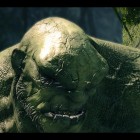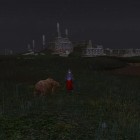Sisyphos had grown bored of it, had an idea and flung his rock at Hades. Broadly, this is the story in the First Chapter of the alternative history book of Rock of Ages. Even this basic idea is a flash of genius, and I still didn’t told you about the grotesque gameplay sparing no one and nothing. Even Leonardo da Vinci would enjoy it, not to mention the three hundred Spartans. Nowadays, I substantially set indie games before the AAA categorized products from the conveyor belts of an industry investing and getting millions of dollars into and from lifeless games with zero innovation and value. The good indie developers must accomplish to satisfy the income-hungry publishers, so they have to show all their boldness in their games. ACE Team is an excellent example for this direction: In 2009 its Zeno Clash overshot the mark, and I mean it in the good meaning. And it didn’t changed a bit in the case of this rock-rolling madness, which somehow got the category of action-strategy. I already told you about the foundation of the story, and I hope I don’t have to explain names like Sisyphos or what we call a Sisyphean task. Let’s take a look at the gameplay instead, which is entertaining in itself. In the beginning of every level a short animation lets you know about the century, in which you have to roll that big rock. You get to know your enemy too: They can be anyone from Hades through Leonardo da Vinci to Napoleon. And of course, they try to roll another rock onto your half of the pitch. This videos are funny and grotesque. Nothing is sacred for the developers, not even Leonidas, “This is Sparta” for nothing. The rock is controlled by you. Left, right, brake and jump. The goal is to roll downhill, avoid harm and cause a lot of damage to the enemy’s objects, then in the end you need to smash the enemy gates and simply squeeze him to death. The rolling race has some spice, of course; the enemy has his rock too, so also your gate is in danger. To avoid defeat, you can build...
Penumbra: Black Plague
There are games that worth their prices. Well, the mascot of Frictional Games, the second episode of the Penumbra series, the Black Plague just belongs to this category. And this is quite true if you buy a localized version, which means that nor just the menu and the hub, but the dub will be localized too ― at least Hungarian version is worth the money, thanks to CD Projekt. The first episode of Penumbra was also good, if I wanna pen it with mild terms, and it had a relatively big success in spite of its unhyped release. The reception was fishy a little, but commendatory voices were predominant. The second installment goes uber on almost every aspect of the first episode. I try to examine this game to see what it brings up, and what the developers didn’t manage to improve… We Don’t (?) Go Step by Step Characteristically, the game has exceptionally lifelike physics, acceptable graphics and lots of hard puzzles. In the first episode we might get to know the physics, or I can say: We could see how professional the 4 swede undergrad guys were regarding the simulation of physics. Every object was falling, breaking, exploding, etc. just as in real life. Well, Black Plague shows it no otherwise, so the engine ― I can say ― became a trademark of the game and the series. Unfortunately, it seems that short playtime became a trademark too. Another thing we can raise objection against is graphics, which is nowhere to Crysis. What’s more, it could be an eyesore at first that the game is not fine even on 1280×1024, but I think and found it not a big setback on long terms, because after a time I neglected it entirely. What made me cry again was the bad appearance and animation of characters. Sadly and inexplicably they didn’t improve these, and some monsters raise rather a smile than fear ― it’s not typical, but it can occur. OK, after hurting the game a little I list its good characteristics, because there are a lot of them. Let’s Go Through the Door… But How? After the end of the first episode it was...
Of Orcs and Men — Green Revolution

2014. nov. 12.
Generally I like crossovers in every area, because if the creators are combining the elements of various genres well, the mix can be something good, even if the product shows no really new or unique content in the depths. Since the re-adoptation of Blood Bowl the name of the french Cyanide started to be the synonym of quality entertainment, and the fine-tuned crossover of Of Orcs and Men wrote it onto the list of companies drawing attention. Even the title grabbed my attention, because it refers to Steinbeck‘s Of Mice and Men, and the similarity goes further. We get the small and agile character as well as the slow giant, and there is a sentence in the synopsis of the book that fits well on this very game: “…clinging together in the face of loneliness and alienation.” The trailers bought me with the story: Humans wage total war against the greenskins, a part of the orc race is already eradicated, and the other part is mostly enslaved. But humans did not take an important thing into account: The orcs seem wild, unorganized and barbaric on the outside, but in fact they have an advanced culture with mostly strength-based but solidly contoured power hierarchy in it. And, you know, they have an elite squad. These elites are the Bloodjaws, and have a jaw tattoo on the right breast – and of course the main hero, Arkail is a part of the team. You get the mission summarized in a very orcish way: Get through the wall, search and kill the emperor! Really, this is it. But the completion is much more difficult than the summary of the mission. The first and most important thing: They hire a guide for you to lead you through the city wall. He is no other than Styx, the only goblin in the world ever heard speaking and ever showed signs of intelligence. Not to mention, he is the narrator of the story and swearing is not far from him. So that’s it, you have the odd couple, and their only mutual attribute is their green skin. The differences would make an enormous list, so I stick to the essentials....
Minority Report: Mass Effect 2
Don’t misunderstand it: “Minority report” is never about bad games. Rather it’s about enjoyable games full of flaws which, by well intentions, can be looked over during playing, but on the whole they bring the global impression about the game down. They are “ok, but…” and “I liked it, but…” types of flaws. And there is another important thing: I don’t choose games for writing minority reports because they are favorites of one or other editor of GameDroid. Of course, my favorites can be subjects of articles like this. What’s more, I would gladly read that if someone would point at the lacks and misses I didn’t see. Effect of the Masses Here, on GameDroid I already lamented about the situation of CRPGs today, and I emphasized the genre-destroying works of BioWare when they qualify their excellent action-adventure games as RPGs, in which genre these otherwise outstanding games can be only weak flicks. I was also screaming in the past when they called Mass Effect 1 a CRPG, because the running-in-tubes-shooting gameplay and the unimpressionable story contradict the labeling too much. Then Mass Effect 2 came to the shops as one of the main representatives of the genre – although, as some refinement it is often called action-RPG or shooter-RPG. For me, it remains an action-adventure game, and with this I consider the labeling topic closed. Besides being a gamer and liking adventure games I was interested in ME2 also because not only the faceless masses, but some of my friends too speak about it in superlatives. So marketing worked well: The masses drew the attention of my friends, and their opinion drew mine too. Chief Miner Let’s have a go at this: Mining is the lamest among the many legs of Mass Effect 2. Not just it eats up half or even quarter fifth of your playtime (it depends on you being exhaustive or not), but there are some major inconsequences in it. It can be seen with half an eye that you are the only miner in the galaxy. Half of the planets have rich deposits which can be depleted completely – in the same time, on a few planets there are...
Lord of the Rings Online ― Multisolo

2014. nov. 11.
When talking about fantasy MMOs, LotRO mustn’t be left out. This online variation of the the world of Lord of the Rings is worthy of the big ancestor and namegiver, and although gameplay is not so unique, you won’t find too many flaws in it. It is free since September (2010.), for which cause it was left by thousands and started by millions, so the conversion seems like a valid pull. There is a disagreement on the web between the fans of f2p (free to play) and pfp (pay for play), but I won’t go into it: I see reasons in both the fully paying and the microtransaction model alike. I rather write about the game. The American publisher, Turbine (and Codemasters in Europe) follows the same principle in LotRO than in Dungeons and Dragons Online (DDO): A free player can have such points that he/she can use for paying in the online store of the game, so this way even free players can have almost anything that paying players get. While in DDO you need to complete the quests again and again (this repetition was why I get bored of it time and time again, but otherwise it’s a good game), LotRo handles this part of the system as a separate type of tasks. These are the heroic deeds, and although they are in a defined number, but playing with two characters (free game allows only two) you still can get enough Turbine Points to get horses, maybe remove the money cap, buy some quest packs (each belongs to one or other lands of Middle Earth), etc. If you create the two characters to augment each other in ways, you can easily find yourself undecided regarding which one you will play next time you start the game. I ran forward a little. I was at the tasks: Besides heroic deeds there is an epic story, and between the quests of it you can handle all the sidequests, your hobby, your crafts and the events of the war. Ups, this sounds a bit too many in the same breath — indeed it is. It is so many that I mostly neglect the main story,...

Legutóbbi hozzászólások